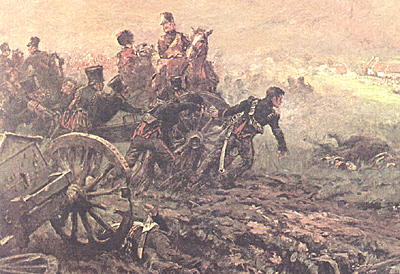Netherlands Artillery
in the Waterloo Campaign
Horse Artillery Battery ‘Krahmer’
by Geert van Uythoven, The Netherlands
| |
Krahmer deploying his bettery. On 17 November he was posted with the horse artillery that was raised in the Southern Netherlands, with orders to raise two companies in Mechelen (7th and 8th company) with which a horse artillery battery would be made mobile. Other officers: 1st Lieutenant Nicolas Jean de Villers du Dufourneau; 1st Lieutenant Jacobus Lambertus van der Smissen; 2nd Lieutenant Jan Baptist van der Steen. Train detachment: 1st Lieutenant Seitz. On 12 June 1815 the battery had a strength of 3 officers, 120 others, and 120 horses. The train detachment had a strength of 3 officers, 84 others, and 162 horses. The battery was notorious for the high rate of desertion, even after Waterloo, deserters even taking their horses and weapons with them! [2]
This battery was armed with six short 6-pdr bronze cannon, and two 24-pdr (iron) bronze howitzers. On 7 April 1815 the battery, served by both companies and ready to take the field, was at Brussels. A few days later, it joined its Division in its cantonments. The Horse artillery battery ‘Krahmer’ was assigned to the 1st Brigade (Colonel Hendrik Detmers) of the 3de Nederlandsche Divisie (Lieutenant-General David Hendrik Baron Chassé), [3] not taking part in the battle of Quatre-Bras. However, during the battle of Waterloo, the 2nd Brigade (Major-General Alexander Carel Joseph Gislain d’Aubremé) of the 3rd Division stood near Braine l’Alleud village on the far right flank. Therefore, the more mobile Horse artillery battery ‘Krahmer’ was attached to it, while the battery ‘Lux’ came on the inner left wing of the Division, attached to Detmer’s Brigade which occupied the village itself.
At 3.00 p.m., the 2nd Brigade was ordered to link up with the British 2nd Division (Clinton), placed in second line on the right wing of the Anglo-Allied army. The Division was placed in low ground
along the chaussee from Nivelles to Mont St. Jean, about 500 metres behind the Guard brigades ‘Byng’ and ‘Maitland’. With the Foot artillery battery ‘Lux’ still at Braine l’Alleud, Horse artillery battery ‘Krahmer’ was divided into two half batteries, placed on the wings of both infantry brigades. When later the Foot artillery battery ‘Lux’ arrived, both batteries were united and positioned some distance behind the infantry under the command of Major Van der Smissen.
[4]
When around 7.30 p.m. Lieutenant General Chassé noticed that the fire of the British artillery in front of him slackened, because of sustained casualties of the heavy French artillery fire and lack of ammunition, in addition observing the advance of the French Guard, he took the initiative to order Major Van der Smissen to sent the forward the first half battery [5] of ‘Krahmer’ into the firing line, to the former position of Captain Cleeve’s battery. Upon receiving the order, the half battery galloped along chaussee to Nivelles, following Krahmer who rode far ahead, pointing with his sabre to the space where he wanted the guns to be deployed. Turning round the left wing of the British Guards, the four guns deployed in line between the Brigade of Sir Colin Halkett and the Brunswick battalions in the first line, be-hind the hollow road, to the left and backwards of Lloyd’s artillery battery, behind the position
where Cleeve’s battery had stood. [6]
They immediately opened fire against the French guard artillery batteries west of La Haye Sainte, which were enfilading the British artillery. Enfilading these on his turn, the French artillery was forced out of its position. A few moments later, the other half of Krahmer’s artillery battery deployed to the right of forward half battery, starting to fire at the advancing French Guard infantry, “and literally cut lanes through the column in our front”.
[7]
When around 8.00 p.m. the 1st Brigade (Detmers) charged the French guards, led by Lieutenant-General Chassé again on his own initiative, Horse artillery battery ‘Krahmer’ also advanced and supported the infantry under the direction of Major Van der Smissen. When the French retreated, night already falling, the battery limbered and took part in the pursuit of the French army, firing grapeshot into their wavering ranks twice and contributing to its final rout. The battery bivouacked near Rossomme that night. During the battle, the battery ‘Krahmer’ lost 27 men dead, and 21 men wounded. After Waterloo, the 3rd Division became part of the 1st Netherlands Army Corps (Prince William of Orange), which took part in the advance on Paris. When Paris had been occupied by the Allies all Netherlands artillery bivouacked in the Bois de Boulogne, west of Passy. On 17 July the 3rd Division moved to the valley of Montmorency, with the battery ‘Krahmer’ at Domont. On 30 November the battery marched back to the Netherlands with the 1st Brigade, being garri-soned in Breda.
Netherlands Artillery in the Waterloo Campaign 1815 Part III: Artillery Batteries and Companies
Netherlands Artillery in the Waterloo Campaign 1815 Part II: Artillery Officers [First Empire 72]
Netherlands Artillery in the Waterloo Campaign 1815 Part I [First Empire 71]
|
 This ‘southern’ battery was served by the combined 7th and 8th company of the Horse artillery corps. The battery was commanded by Captain Carel Frederik Krahmer de Bichin (28 years old). Joining the Netherlands army, on 23 July 1814 Krahmer was assigned to the artillery in the Southern Netherlands as a captain.
This ‘southern’ battery was served by the combined 7th and 8th company of the Horse artillery corps. The battery was commanded by Captain Carel Frederik Krahmer de Bichin (28 years old). Joining the Netherlands army, on 23 July 1814 Krahmer was assigned to the artillery in the Southern Netherlands as a captain.